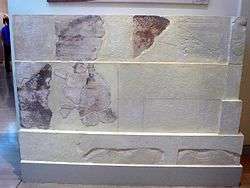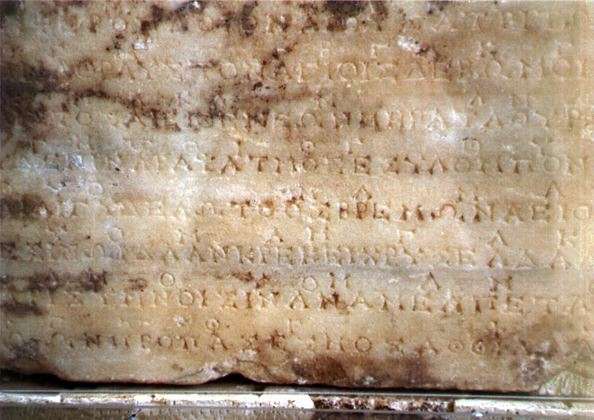Delphic Hymns

The Delphic Hymns are two musical compositions from Ancient Greece, which survive in substantial fragments. They were long regarded as being dated circa 138 BCE and 128 BCE, respectively, but recent scholarship has shown it likely they were both written for performance at the Athenian Pythaides in 128 BCE (Pöhlmann and West 2001, 71–72). If indeed it dates from ten years before the second, the First Delphic Hymn is the earliest unambiguous surviving example of notated music from anywhere in the western world whose composer is known by name.
History
Both Delphic Hymns were addressed to Apollo, and were found inscribed on stone fragments from the south outer wall of the Athenian Treasury at Delphi in 1893 by French archaeologist Théophile Homolle, while Henri Weil restored the Greek text and Théodore Reinach transcribed the music to modern notation (Weil 1893; Reinach 1893). Reconstruction of the fragments was facilitated by the fact that the first hymn uses vocal notation, and the second one employs instrumental notation (Pöhlmann and West 2001, 70). It was long been believed that all that could be told of the composer of the First Hymn is that it was written by an Athenian, around 138 BCE, since the heading of the inscription giving the name of the composer is damaged and difficult to read. However, careful reading of this inscription shows that it cannot be the ethnic "Athenaîos" (from Athens), but rather names "Athénaios Athenaíou" (Athenaeos son of Athenaeos) as the composer (Bélis 1992, 48–49, 53–54; Pöhlmann and West 2001, 71). The Second Delphic hymn has been dated to precisely 128 BC; evidently it was first performed in the same year. The name of the composer has also survived, both in the heading of the hymn and in a separate inscription: Limenios, son of Thoinos, an Athenian (Pöhlmann and West 2001, 71). The occasion of the performance of both hymns was the Pythaid, a special religious procession of the Athenians towards Delphi held on specific occasions usually after certain omens.

Modern reconstruction performed on computer |
Some of the pitches in this version are mere guesses (as to the readable pitches, see Pöhlmann and West 2001, 62–85).
First Delphic Hymn
Both hymns are monophonic (consisting of a single melodic line), but are differentiated by their notation. The First Hymn is in so-called vocal notation and it is in the cretic (quintuple) meter throughout (Pöhlmann and West 2001, 70–71, 85). It is in the Phrygian and Hyperphrygian, with much variation: an archaic pentatonic effect is produced in the lowest tetrachords by avoiding lichanos, while above mese (nominally middle C) there is modulation between a conjunct chromatic tetrachord (C D♭ D F) and a disjunct diatonic one (D E♭ F G), extended by two more chromatic notes, A♭ and A (Pöhlmann and West 2001, 73). In addition to being the earliest surviving substantial fragment of ancient music, the First Delphic Hymn may also have been the longest, perhaps even longer than the Second Delphic Hymn, which runs to 40 lines; unfortunately, the First Hymn does not survive complete (the Seikilos epitaph, dated anywhere between the 2nd century BCE and the 1st century CE, is the earliest surviving complete piece of music).
Exact performance practice is unknown, but Limenius is mentioned in a separate Delphic inscription as a master player of the kithara; likely he accompanied a singer or singers.
The First Delphic Hymn falls into two large parts, a Paean (lines 1–27) and what might have been called a Hyporchema (lines 27–34). The hymn is set in cretics throughout (Pöhlmann and West 2001, 85).

Second Delphic Hymn
The Second Hymn is headed Paean and Prosodion to the God (Pöhlmann and West 2001, 75, 85). It consists of ten sections in all, the first nine in cretic metre constituting the paean, the tenth in aeolic rhythms (glyconics and choriambic dimeters) is the prosodion. Their tonalities are (Pöhlmann and West 2001, 85):
- Lydian
- Hypolydian
- Hypolydian
- Chromatic Lydian
- Hypolydian
- Hypolydian
- Chromatic Lydian
- Hypolydian
- Lydian
- Lydian
Verses
The musical symbols used for the hymns have been interpreted by the experts thanks to a treatise by Alypius, a musicographer of Late Antiquity (3rd century A.D.). The verses are related to various events from the life of the Apollo, such as his birth, his advent to Delphi, his support of the war against the Gauls etc.
Aftermath
These hymns were thoroughly examined by musicologists and there have been many efforts to perform them with replicas of ancient musical instruments. The first time that they were performed was in 1894, one year only after their discovery, during the international athletic convention for the establishment of the modern Olympic Games.
See also
Recordings
- Arda Mandikian recorded these fragments at Delphi in 1950 (Warrack 2013)
- Musiques de l'Antiquité Grecque: De la Pierre au son. Ensemble Kérylos, directed by Annie Bélis. K617, 1996. K617-069.
- D'Euripide aux premiers chrétiens : musiques de l'antiquité grecque et romaine. Ensemble Kérylos, directed by Annie Bélis. 2016. Both Hymns are played, the first is performed by a baritone (Jan Jeroen Bredewold) with tympanon (Annie Bélis), the second by a bass-baritone (Frédéric Albou) with Kithara (Benoît Tessé) and Transverse Aulos (Nathalie Berland).
- Music of Ancient Greece. OP and PO Orchestra, conducted by Christodoulos Halaris. Orata. ORANGM 2013.
- Music of the Ancient Greeks. De Organographia (Gayle Stuwe Neuman, Philip Neuman, and William Gavin). Pandourion Records, 1997. PRDC 1001.
- Musique de la Grèce antique. Atrium Musicæ de Madrid, Gregorio Paniagua, dir. Harmonia Mundi (France), 1979. HMA 1901015.
References
- Anderson, Warren, and Thomas J. Mathiesen. [2001]. "Limenius," Grove Music Online, edited by Laura Macy (Accessed 24 August 2005), (subscription access)
- Bélis, Annie (ed.). 1992. Corpus des inscriptions de Delphes, vol. 3: "Les Hymnes à Apollon". Paris: De Boccard. ISBN 2-86958-051-7.
- Davison, Archibald T., and Willi Apel (eds.). 1949–50. Historical Anthology of Music. Two volumes. Cambridge, Massachusetts, Harvard University Press, 1949. ISBN 0-674-39300-7.
- Pöhlmann, Egert, and Martin L. West. 2001. Documents of Ancient Greek Music: The Extant Melodies and Fragments, edited and transcribed with commentary by Egert Pöhlmann and Martin L. West. Oxford: Clarendon Press. ISBN 0-19-815223-X.
- Reinach, Théodore. 1893. "La Musique des hymnes de Delphes". Bulletin de Correspondance Hellénique 17:584–610.
- Reinach, Théodore. 1926. "La Musique grecque". Paris: n.p.
- Warrack, John. 2013. "Mandikian, Arda (1924?–2009)". Oxford Dictionary of National Biography. Oxford and New York: Oxford University Press (accessed 7 Sept 2015). (subscription required)
- Weil, Henri. 1893. "Nouveaux fragments d'hymnes accompagnés de notes de musique". Bulletin de Correspondance Hellénique 17:569–83.
- Weil, Henri. 1894. "Un Nouvel Hymn à Apollon". Bulletin de Correspondance Hellénique 18:345–62.
- West, M[artin] L[itchfield]. 1992. Ancient Greek Music. Oxford: Clarendon Press; New York: Oxford University Press. ISBN 0-19-814897-6 (cloth); ISBN 0-19-814975-1 (pbk).
External links
| Wikimedia Commons has media related to Delphic hymns to Apollo. |
- Limenios: Paean and Processional: contains a photograph of the original engraved stone at Delphi.
- Hymne à Apollon, Gabriel Fauré's accompaniment for harp, at IMSLP
- Ensemble Kérylos a music group directed by scholar Annie Bélis and dedicated to the recreation of ancient Greek and Roman music.
- Delphi Historical Information, including a description of the hymns
- Synthesised recording used in the game Civilization 3